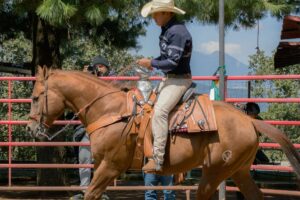
Establishing effective communication between riders and their horses is crucial for achieving harmony and precision in equestrian activities. One tool that aids in this communication process is the Romal reins. In this article, we will explore the benefits and techniques of using Romal reins to improve communication with your horse, promoting a stronger partnership and enhanced riding experience.
Understanding Romal Reins: Romal reins are a specialized type of rein commonly used in Western riding. They consist of a single rein, typically made of leather, that is attached to a bit and a longer, weighted end known as the Romal. The Romal is usually made of braided rawhide or leather and is held in the rider’s hand.
Benefits of Romal Reins:
- Clear and Precise Signals: Romal reins provide riders with a longer and heavier rein end, enabling clearer and more precise signals to be conveyed to the horse. This increased control helps in refining movements and maintaining consistent communication throughout various maneuvers.
- Balance and Collection: The weight of the Romal aids in maintaining balance and encouraging the horse to collect, promoting engagement of the hindquarters and a light, responsive feel in the horse’s mouth. This improves overall body control and responsiveness to the rider’s cues.
- Versatility: Romal reins can be used in a variety of disciplines, including reining, western pleasure, trail riding, and working cow horse. They offer versatility and adaptability, making them suitable for both show and recreational riders.

Using Romal Reins Effectively:
- Proper Hand Positioning: Hold the Romal reins in one hand, allowing the Romal end to hang loosely and securely, while maintaining a soft and steady contact with the horse’s mouth through the bit. Avoid excessive tension or constant pulling on the reins, as it may create confusion and resistance in the horse.
- Rein Aids and Signals: Utilize subtle movements and cues through the Romal reins to communicate with your horse. For example, lifting the Romal slightly can signal a turn, while gentle vibrations can encourage the horse to maintain a desired gait. Practice these rein aids in a controlled environment before applying them during riding exercises.
- Consistency and Rein Release: Consistency in your rein aids is essential for effective communication. Reinforce your signals by applying consistent pressure and releasing promptly when the horse responds correctly. This helps the horse understand and associate your cues with their desired actions.
Conclusion: Romal reins provide riders with a valuable tool for enhancing communication and developing a deeper connection with their horses. By utilizing proper techniques and understanding the benefits of Romal reins, riders can improve their riding skills, achieve better balance and collection, and create a more harmonious partnership with their equine companions. Remember, practice and patience are key to mastering the art of using Romal reins effectively and enjoying the benefits they offer in your equestrian pursuits.






